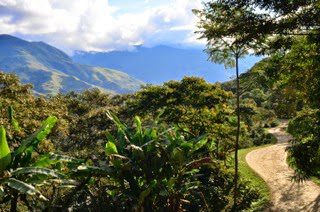Moving to the Country and Slowing Down

First-year missioner Mary Mortenson talks about her and her husband’s recent move so that they could serve in different ministries at a rural Catholic university (photo by Nate Mortenson).
For those of you who do not know me all that well, I rarely leave a place with all my boxes checked and all my bows tied. Often it’s more comparable to a cloud of dust and a panicked frenzy, and I’m usually a bit of an emotional mess.
So in usual fashion, our move from Cochabamba, Bolivia, to Carmen Pampa, Bolivia, was a whirlwind of goodbyes, last minute packing, and attempting to finish a fairly impossible to-do list. (This is the result of TWO eternal optimists “Sure, we’ll be able to accomplish that”). When we finally got on the bus headed to our new home, I breathed a sigh of relief, naively assuming that we had “made it.”
What I hadn’t considered was that our lives were to go from a fairly fast-paced and on-the-go speed of life, to a meandering stroll – and that may take a little getting used to. We were moving from a city of a little over a million people with transportation right out my door and a food market four blocks away, to a teeny-tiny town that I would be surprised if it appeared on any map. It’s a home to around 40 families and, when school is in session, about 800 university students. But when we arrived it was winter vacation, so we were back to 40 families.
Don’t worry: Nate and I were not being forced into this. We had visited this quaint little college village three times before we committed to moving. No, really, we were very excited for the slower pace of life in the countryside. We like the energy of the students and the philosophy of the school. After a few conversations with different staff on campus, we could see opportunities to serve that worked for each of us.
We thought it was romantic that the electricity turns off on the regular and adventurous that we would have to take a 30-minute bus ride to purchase our groceries. Plus the fact that the college is nestled into the mountainside with hike of 1,500 feet in-between campuses would be a perfect incentive to get a little exercise in and enjoy the beautiful view every day 🙂
Honestly, we knew there would be challenges, but we felt that life in Carmen Pampa would bring us more naturally into relationship with a community in a way that seemed harder in a bigger city. Which has proven to be true, but our transition was harder than expected.
When we finally arrived, it felt like there was no one around and that we were in the midst of rainy cloud that lingered for four days as we attempted to clean and dry out our apartment. Because there were no students and the mountain road was so bad from the rain, it was challenging to navigate transportation into Coroico to buy food or anything else.
I remember the second night we were eating the potatoes that the previous residents had graciously left for us that we had eaten for the previous night’s dinner and that day’s lunch , and I just couldn’t take another bite and after a long tiring day, I opted for an early 7 p.m. bedtime instead. We can laugh about it now, but we truly were caught off-guard.
It’s been almost a month now since we arrived, and country living is suiting us just fine. Well, and the students are back, so that helps. We have made the proper adjustments and preparations for things like the pipes clogging and keeping water from coming out of our faucets. We take our trips to town on Saturday mornings very seriously to accomplish and/or stock up on whatever we need for the week. We factor in a 25-minute sweaty hike to get back to upper campus after we’ve had meetings or other business. We plan on checking our e-mail once a week instead of several times a day like we did in Cochabamba and doing most of our communication with students and staff on campus in-person or by hand-written notes. And that is why we like this place so much, it really causes us to slow down and enjoy. It suits us.
The most important thing is that we’ve been reminded that things don’t happen at the snap of your fingers. Things take time. As we are learning that lesson, we are also getting to know the students, staff, and other community members. But that takes time, too. We appreciate that although we have been warmly welcomed, students will take their time to develop trust with us. As we work side by side, we will start to understand the gossip and the jokes, and we’ll earn the privilege of hearing students’ stories.
Right now, I’m hoping that this pace of life will stick around for a bit.
Tagged in:
